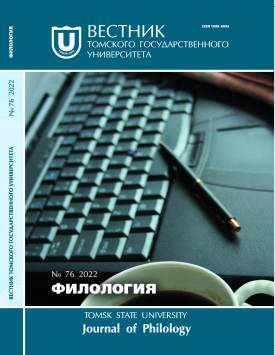Complementing and eliminating images as cognitive ways of generating new conceptual meaning in secondary phraseologization
The article discusses the structural and semantic modifications of conventional phraseological units, in which a change in the formal structure of original phraseological units entails the generation of a new semantic meaning, and then a new phraseological unit. In light of the emergence of new scientific concepts, especially in the domain of cognitive linguistics, they attract more and more attention of linguists, since they reflect the peculiarities of the complex activity of the human brain in obtaining, processing, and using of verbalized knowledge. The aim of the article is a detailed description from a cognitive point of view of the processes of complementing and eliminating images during secondary phraseologization by modeling the mental spaces of the components of the original phraseological unit and the integrated space of the generated phraseological unit, in which a new conceptual meaning develops. The research material is the neological phraseological units of the journalistic discourse of the modern French language formed as a result of these processes, which have appeared for the last 10 years. This research is based on the cognitive concepts of meaning generation, namely, on the theory of mental spaces and conceptual integration developed by Gilles Fauconnier and Mark Turner. Reasoning from the structure of mental spaces (sacred, profane and metaphorical spheres), as well as their ability to integrate, the author models the mechanism of generating a new conceptual meaning during the formation of a neological phraseological unit. The analysis of the complementing shows that the initial conceptual meaning can be replenished with new images (image of the performed action or state, image of the attribute of the nomination object, the image of a new scenario, the image of the performer of the action, the image of the attribute of the action, the image of the scene), as a result of which the original phraseological unit acquires a new conceptual meaning. Elimination of images, in which the structural organization of the original phraseological unit is reduced, supposes two ways of developing a new conceptual meaning: categorical transformation of the original phraseological unit and development of conceptual meaning in the direction from a specific to a generalized meaning. In the course of the study, the author comes to the conclusion that the cognitive basis for generating a new conceptual meaning is the rethinking of the images available in the original mental spaces, which reflects the basic procedures of a person’s thinking during secondary phraseologization, as well as their life and speech experience. The author declares no conflicts of interests.
Keywords
secondary phraseologization,
mental space,
generating space,
integrated space,
complementing,
eliminationAuthors
| Moisiuk Valentina A. | Chernivtsi National University | hladka_valya@yahoo.fr |
Всего: 1
References
Fauconnier G. Mental Spaces: Aspects of Meaning Construction in Natural Language. Cambridge, 1994. 240 p.
Козлова Н.Н. Моделирование ментального пространства как этап выявления фразеологического значения (на примере ментального пространства green) // Гуманитарный вектор. 2010. № 2: Филология. С. 117-124. URL: https://cyberleninka.ru/article/n/modelirovanie-mentalnogo-prostranstva-kak-etap-vyyavleniya-frazeologicheskogo-znacheniya-na-primere-mentalnogo-prostranstva-green/viewer
Бурдье П. Практический смысл / пер. с фр. А.Т. Бибиков, Е.Д. Вознесенская, С.Н. Зенкин, Н.А. Шматко. М. ; СПб., 2001. 562 с.
Колмогорова А.В. Языковое значение и речевой смысл: Опыт функционально-семиологического исследования прилагательных-обозначений светлого и темного в современных русском и французском языках. Новокузнецк, 2006. 380 с.
Fauconnier G., Turner M. The way we think : Conceptual blending and the mind’s hidden complexities. New York, 2002. 464 p.
Fauconnier G., Turner M. Mental Spaces. Conceptual Integration Networks. Cognitive Linguistics: Basic Reading. 2006. P. 303-371.
Джаграева М.Л. Коммуникативно-прагматические особенности фразеологической деривации : дис.. канд. филол. наук. Ставрополь, 2005. 182 с. URL: http://cheloveknauka.com/
Кунин А.В. Курс фразеологии современного английского языка. М. : Международные отношения, 1996. 381 с.
Ларин Б.А. Очерки по фразеологии: (О систематизации и методах исследования фразеологических материалов) // История русского языка и общее языкознание. М., 1977. С. 125-149.
Чередниченко В.О. Інноваційна фразеологічна вербалізація в англійській мові (лінгвокогнітивний та соціолінгвістичний параметри) : дис.. канд. філол. наук. Запоріжжя, 2005. 220 с. URL: http://www.allbest.ru/
Шанский Н.М., Иванов В.В. Современный русский язык : в 3 ч. Ч. 1: Введение. Лексика. Фразеология. Фонетика. Графика и орфография. М., 1987. 192 с.
Мізін К.І. Компаративні фразеологічні одиниці сучасноі німецькоі мови: шляхи утворення та ідеографія : автореф. дис.. канд. філол. наук. Киів, 2004. 20 с. URL: http://allbest.ru/
Макаев Э.А. Понятие давления системы и иерархия языковых единиц // Вопросы языкознания. 1962. № 5. С. 47-59.
Виноградов В.В. Избранные труды: Лексикология и лексикография. М., 1977. URL: http://www.philology.ru
Добровольский Д.О., Караулов Ю.Н. Ассоциативный фразеологический словарь русского языка. М., 1994. 116 с.
Добровольский Д.О. Образная составляющая в семантике идиом // Вопросы языкознания. 1996. № 1. С. 71-93.
Мокиенко В.М. Славянская фразеология. М., 1989. 287 с.
Hafller G., Hummer Ch. Figement et defigement polylexical: l’effet des modifications dans des locutions figees // Linx: Revue des linguistes de l’universite Paris X. 2005. № 53: Le semi-figement. P. 103-119. URL: http://linx.revues.org/266
Rey A., Chantreau S. Dictionnaire d’expressions et locutions. Paris, 2007. 1087 p.
Dictionnaire de franjais. Paris : Larousse, 2020. URL: http://www.larousse.fr/dictionnaires
Потебня А.А. Теоретическая поэтика. М., 1990. 344 с.
Блинова Е.В. К проблеме типологии отфразеологических фразеологизмов // Русская и сопоставительная филология: состояние и перспективы : междунар. науч. конф., посвященная 200-летию Казанского ун-та. Казань, 2004. С. 47-48.
Ренская Т.В. Эллипсис фразеологических единиц в русском языке : автореф. дис.. канд. филол. наук. Ростов н/Д, 1983. 24 с.
Вардуль И. Ф. Основы описательной лингвистики (синтаксис и супрасинтаксис). М. : Наука, 1977. 352 с. URL: https://www.booksite.ru
Баранов А.Н., Добровольский Д.О. Структуры знаний и их языковая онтологизация в значении идиомы // Исследования по когнитивным аспектам языка. Труды по искусственному интеллекту : учен. зап. Тартус. ун-та. Тарту, 1990. Вып. 903. С. 20-37.
Большой психологический словарь / сост. и общ. ред. Б. Мещеряков, В. Зинченко. СПб., 2004. 672 с.

